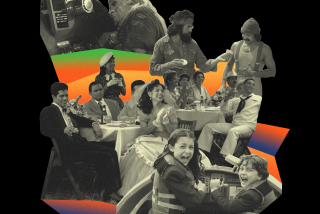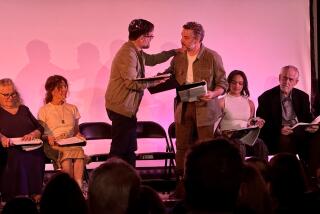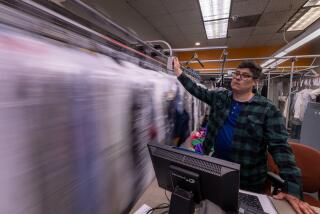Street Drama : Actor Edward James Olmos Plays Leading Role in Cleanup Effort
The Sikh man in the purple turban and gray beard smiled broadly and rushed to shake the hand of Edward James Olmos.
“We saw you on TV!” he said. “We were so impressed!” He had driven from Orange County with 20 other Sikhs to join in sweeping rubble from the streets of Los Angeles.
A Latino youth, his face covered with soot from a burned-out mini-mall that he was helping clean, sidled up to Olmos. “Man,” he whispered into the actor’s ear, “I was praying someone would speak to us. I looked at the TV, and there you were.”
Olmos, the raspy-throated, hardly glamorous star of television and movies, emerged at the height of last week’s revolt as a voice that many of the city’s residents wanted to hear.
Walkie-talkie in hand, Olmos for three days led cleanup brigades through South Los Angeles and downtown and dispatched hundreds of volunteers to blighted corners.
More than many leaders in the political Establishment, Olmos managed to inspire numerous people to take a broom to the streets. Perhaps it is fitting that in celebrity-worshiping Los Angeles, it takes an actor to mobilize people.
But it may say more about the sterile void that out-of-touch politicians have created.
“He was out there, pushing a broom, and I said: ‘Why not?’ ” said Michael Haysom, who sells Mercedes-Benz parts in Buena Park. “The way his words were, it didn’t seem he was talking from his ego.”
“Eddie, to me, he’s the Pied Piper,” said Olmos’ friend Steve Valdivia, who runs a gang-rehabilitation program. “He walks his talk.”
By no means was Olmos alone in organizing the cleanup; the First African Methodist Episcopal Church was one entity that took a leading role. But with Olmos’ keen manipulation of the media, he was one of the most highly visible.
Olmos said he came forward as riots swept Los Angeles because he thought youths, especially Latinos, would listen to him. Born and raised on the Eastside, Olmos’ work with gangs and in other community projects seems to give him a measure of credibility and moral authority that few public figures have.
In a live television appearance Thursday night as the city burned, he spoke via remote hookup to two young looters, and challenged them to join him with a broom the next morning in South Los Angeles. By 6 a.m., 25 people showed up, Valdivia said, and by 10 a.m. there were 200.
From there, it snowballed.
On Sunday, Olmos, 45, was on his third day of commanding the troops. He was tired and sweaty. He wore a white headband across his brow, and a blue swatch of cloth was tied to his forearm--both, he said, to symbolize solidarity with the suffering of Korean-Americans who lost their livelihood in the riots.
He stood at the corner of Washington Boulevard and Main Street, amid the ruins of a strip mall. Dozens of volunteers swarmed around, sweeping blackened rubble with new brooms, filling bright-orange trash bags with debris, hauling them to a donated trash bin.
“Wear gloves!” he shouted to one group, as he ran up and down the sidewalk and across the street.
“Vamos a comer!” he shouted to another. “Let’s eat!”
A catering service that usually feeds crews on Olmos’ movie sets brought 500 shaved-turkey sandwiches and bags of cookies to the volunteers.
Barking into his walkie-talkie, the black-haired former rock singer instructed that volunteers be sent to clean out a nearby Thrifty’s store, ordered a medic to tend to a young man who had cut his foot, and coordinated shipments of rubbish to a landfill.
Olmos’ activities this hot, sunny day were more managerial than janitorial. In between his frenetic duties, Olmos signed autographs, lots of autographs. And he posed for photographs. First with two lithe Fountain Valley women in shorts and tight tank tops. Then with families, kids and other admirers.
“It’s the least I can do,” he told a reporter accompanying him.
A fellow actor paused with his broom, thanked Olmos for the efforts and pledged himself to ongoing community service. A Latina mother gushed and hugged him.
After work was completed at Washington and Main, Olmos and his crews moved to another mini-mall where the Thrifty’s, an auto parts store and a shoe store had been ransacked. Five standing inches of gooey water mixed with filthy debris filled the buildings. Setting up an assembly line, the volunteers shoveled out the mess within a couple of hours.
“I’m here because I want to clean up the image of Latinos,” said Jose Luis Reza, 22, who is president of the Mecha chapter at Compton College. “It is really shameful to see our youth looting other people’s properties. . . . Olmos, as a figure, is a good example to follow, especially for Chicanos.”
From there, Olmos was off to a meeting with Gov. Pete Wilson and about 25 Latino community leaders on the 16th floor of the Ronald Reagan State Building.
Seated at the long mahogany table, Olmos listened to Wilson for about five minutes before interrupting.
He began with the message that he frequently repeats: A government that spends billions of dollars to bail out savings and loan institutions can surely spend a little more money on education and drug programs. It is no wonder, he says, that the average guy feels completely alienated from the American system.
“Children killing children, for no reason, is what we have produced,” he told Wilson, jabbing his finger in the air toward the governor. “Listen to me well. . . . That has never been seen in the history of mankind. Children killing children--for no reason. And if you’ve got the time, someday I’ll explain it to you.”
More to Read
Sign up for Essential California
The most important California stories and recommendations in your inbox every morning.
You may occasionally receive promotional content from the Los Angeles Times.











